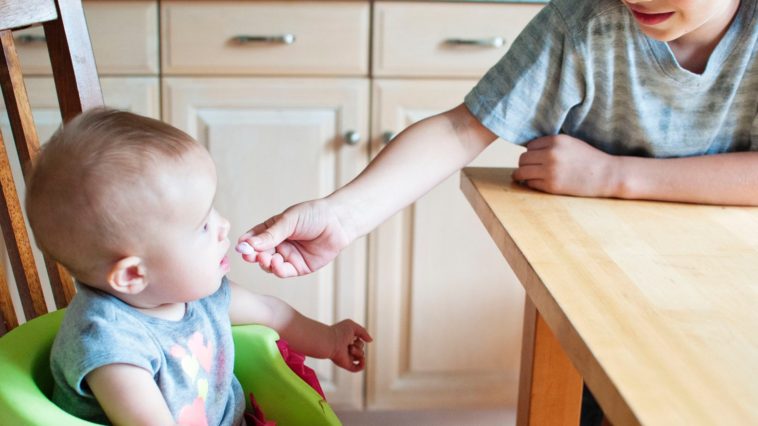How to Know When Your Baby Is Ready for Purées
There is no particular age when your baby will be ready to start eating purées. It just doesn’t happen like that. Age takes a backseat to the signs your baby gives you herself as to her developmental readiness. While pediatricians generally recommend introducing solid food around six months of age, it’s more important that before starting your child on solids you can answer “yes” to most of the following questions:
- Can your baby sit up on her own?
- Is your baby able to hold her head and neck in an upright position?
- Does your baby reach for, or eye, your food while you are eating?
- Is she hungry more often and not satisfied after finishing her usual amount of breast milk or formula?
- Has her weight doubled since birth?
If those questions generate a mix of yes and no answers, it’s no big deal. Just wait a bit. Babies live the lives we adults often wish we could—they do what they want, when they want, no matter what anyone else wants or expects. Your baby might not be ready, even if all of her baby buddies have been eating for months. Your baby might give you all the right indications, but she could absolutely reject her first purée (without a care for all of the love and excitement you put into it, I might add). And you can be sure she won’t be ready when your mother-in-law visits and wants nothing more than to feed her grandchild herself.
Start when the signs are there, and continue to keep trying. At some point, your little one will be ready, and she will open her mouth to her very first bite of food.
How to Introduce Purées
High chair? Check. Bib? Check. Fully charged cell phone? Check.
With this holy trinity of baby-feeding accoutrement, you’re ready for that first feed.
The faces, oh, the faces your baby is about to make. Out of all the firsts, feeding was the most fun—and the messiest. So grab a few wipes, double-check that your phone has enough storage for dozens of photos and videos, and let’s get started.
Before you begin, make sure your baby has a little bit of breast milk or formula in her belly: about half of what you’d normally give in a regular feeding. Not too full. Not too hungry. Just right. It’s also good for you to have a little food in your own belly. Being “hangry” (the very serious condition in which the state of hunger is so severe that one is driven to anger) isn’t good for anyone.
THE PRINCIPLES
This is not going to be a clean and simple process. Your baby may eat food one day, refuse it the next, and paint her face with it the next. It’s all okay. Playing with her food is a good thing; it is simply a way for her to explore, learn, smell, and taste the world around her. So have those wipes close by, and remember:
- Start slowly. Two teaspoons, once a day, is enough food for babies the first couple of meals. Their bodies need time to adjust and digest this new food. If they are still acting hungry, give them some more breast milk or formula.
- Let the baby decide. Your little one should determine the pace of how fast or slow she wants to eat.
- All spoons on deck. Have more than one spoon ready. Your baby will surely snatch one out of your hands to play with, which is a-okay.
- Have fun. Smile at your baby throughout the experience, and try to relax. The more fun you have, the greater the likelihood your baby will enjoy it too (even if she barely eats or doesn’t eat at all).
After a couple of days, you can build up the quantity of food you offer one tablespoon at a time.
THE IDEAL
When you’re ready to start the feeding, select a purée you’ve already made, place just one or two teaspoons of it into its own bowl, and slightly warm this small amount. You can choose whether to gently spoon it into your baby’s mouth or hand the spoon over to her to attempt self-feeding. If your baby tries to grab the spoon from you and get it into her mouth by herself, whoa—you’ve got a success on your hands. If the experience is a bit milder, and she lets you spoon some purée into her mouth, enjoy it. This is a winning experience, too.
How to Introduce New Foods
Your baby has tried her first purée and is loving it—or at least she’s letting you spoon it into her mouth and giving you a perplexed look. Either way, this is a great start. After three or four days of feeding her the first purée, it is time to work in some new ones.
IS YOUR BABY READY FOR SOLID FOOD?
Again, there is no magic age when your baby will be ready to begin eating solid foods. This transition generally takes place around nine months of age, but you’ll know, simply by watching and listening to her subtle clues:
- She refuses to eat off a spoon unless she has complete control over it.
- Her pincer grip has developed, and she can get most foods to her mouth by herself.
- She can eat thicker, chunkier purées without a problem.
- She can easily mush food around in her mouth with her gums.
Now that your baby is ready for solid foods, there are a couple of ways to ease her transition.
CHUNK IT UP The first method is to continue with the same purées you are already making, just in a chunkier consistency. Start slowly by adding a small amount of chunk in an otherwise smooth purée. As your baby adjusts to thicker purées, you can make them chunkier.
- Pulsing: Instead of blending your purées into a smooth consistency, two to three quick pulses in the blender or food processor will allow you to adjust the thickness to your baby’s taste
- Smashing: Take your freshly cooked recipe and smash it down with a fork or potato masher until you reach your desired consistency.
- Increase in Size: Increase the size and quantity of grains, meat, and beans you include in your purées until you finally have incorporated the full item.
Once your little one has mastered eating these chunkier purées, you can simply offer chunks of small and mushy food alongside the chunky purée, always giving them the option of what type of food they prefer.




